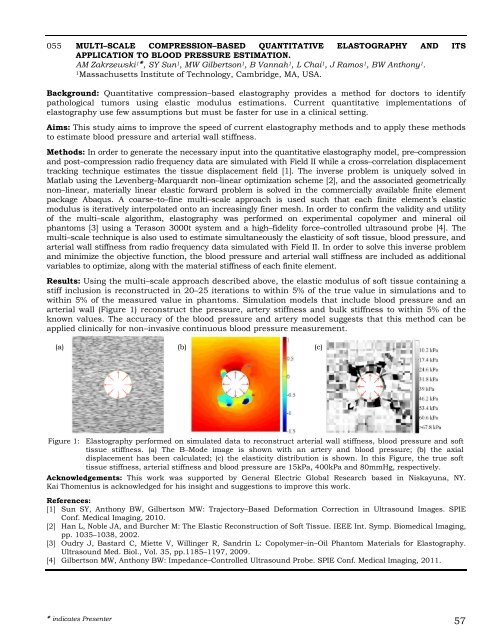2012 Proceedings - International Tissue Elasticity Conference
2012 Proceedings - International Tissue Elasticity Conference
2012 Proceedings - International Tissue Elasticity Conference
Create successful ePaper yourself
Turn your PDF publications into a flip-book with our unique Google optimized e-Paper software.
055 MULTI–SCALE COMPRESSION–BASED QUANTITATIVE ELASTOGRAPHY AND ITS<br />
APPLICATION TO BLOOD PRESSURE ESTIMATION.<br />
AM Zakrzewski 1 , SY Sun 1 , MW Gilbertson 1 , B Vannah 1 , L Chai 1 , J Ramos 1 , BW Anthony 1 .<br />
1 Massachusetts Institute of Technology, Cambridge, MA, USA.<br />
Background: Quantitative compression–based elastography provides a method for doctors to identify<br />
pathological tumors using elastic modulus estimations. Current quantitative implementations of<br />
elastography use few assumptions but must be faster for use in a clinical setting.<br />
Aims: This study aims to improve the speed of current elastography methods and to apply these methods<br />
to estimate blood pressure and arterial wall stiffness.<br />
Methods: In order to generate the necessary input into the quantitative elastography model, pre–compression<br />
and post–compression radio frequency data are simulated with Field II while a cross–correlation displacement<br />
tracking technique estimates the tissue displacement field [1]. The inverse problem is uniquely solved in<br />
Matlab using the Levenberg–Marquardt non–linear optimization scheme [2], and the associated geometrically<br />
non–linear, materially linear elastic forward problem is solved in the commercially available finite element<br />
package Abaqus. A coarse–to–fine multi–scale approach is used such that each finite element’s elastic<br />
modulus is iteratively interpolated onto an increasingly finer mesh. In order to confirm the validity and utility<br />
of the multi–scale algorithm, elastography was performed on experimental copolymer and mineral oil<br />
phantoms [3] using a Terason 3000t system and a high–fidelity force–controlled ultrasound probe [4]. The<br />
multi–scale technique is also used to estimate simultaneously the elasticity of soft tissue, blood pressure, and<br />
arterial wall stiffness from radio frequency data simulated with Field II. In order to solve this inverse problem<br />
and minimize the objective function, the blood pressure and arterial wall stiffness are included as additional<br />
variables to optimize, along with the material stiffness of each finite element.<br />
Results: Using the multi–scale approach described above, the elastic modulus of soft tissue containing a<br />
stiff inclusion is reconstructed in 20–25 iterations to within 5% of the true value in simulations and to<br />
within 5% of the measured value in phantoms. Simulation models that include blood pressure and an<br />
arterial wall (Figure 1) reconstruct the pressure, artery stiffness and bulk stiffness to within 5% of the<br />
known values. The accuracy of the blood pressure and artery model suggests that this method can be<br />
applied clinically for non–invasive continuous blood pressure measurement.<br />
(a) (b) (c)<br />
Figure 1: Elastography performed on simulated data to reconstruct arterial wall stiffness, blood pressure and soft<br />
tissue stiffness. (a) The B–Mode image is shown with an artery and blood pressure; (b) the axial<br />
displacement has been calculated; (c) the elasticity distribution is shown. In this Figure, the true soft<br />
tissue stiffness, arterial stiffness and blood pressure are 15kPa, 400kPa and 80mmHg, respectively.<br />
Acknowledgements: This work was supported by General Electric Global Research based in Niskayuna, NY.<br />
Kai Thomenius is acknowledged for his insight and suggestions to improve this work.<br />
References:<br />
[1] Sun SY, Anthony BW, Gilbertson MW: Trajectory–Based Deformation Correction in Ultrasound Images. SPIE<br />
Conf. Medical Imaging, 2010.<br />
[2] Han L, Noble JA, and Burcher M: The Elastic Reconstruction of Soft <strong>Tissue</strong>. IEEE Int. Symp. Biomedical Imaging,<br />
pp. 1035–1038, 2002.<br />
[3] Oudry J, Bastard C, Miette V, Willinger R, Sandrin L: Copolymer–in–Oil Phantom Materials for Elastography.<br />
Ultrasound Med. Biol., Vol. 35, pp.1185–1197, 2009.<br />
[4] Gilbertson MW, Anthony BW: Impedance–Controlled Ultrasound Probe. SPIE Conf. Medical Imaging, 2011.<br />
indicates Presenter 57









